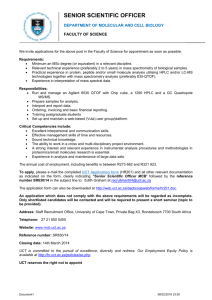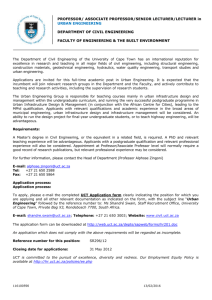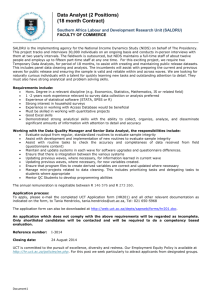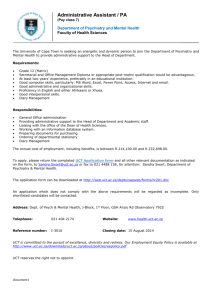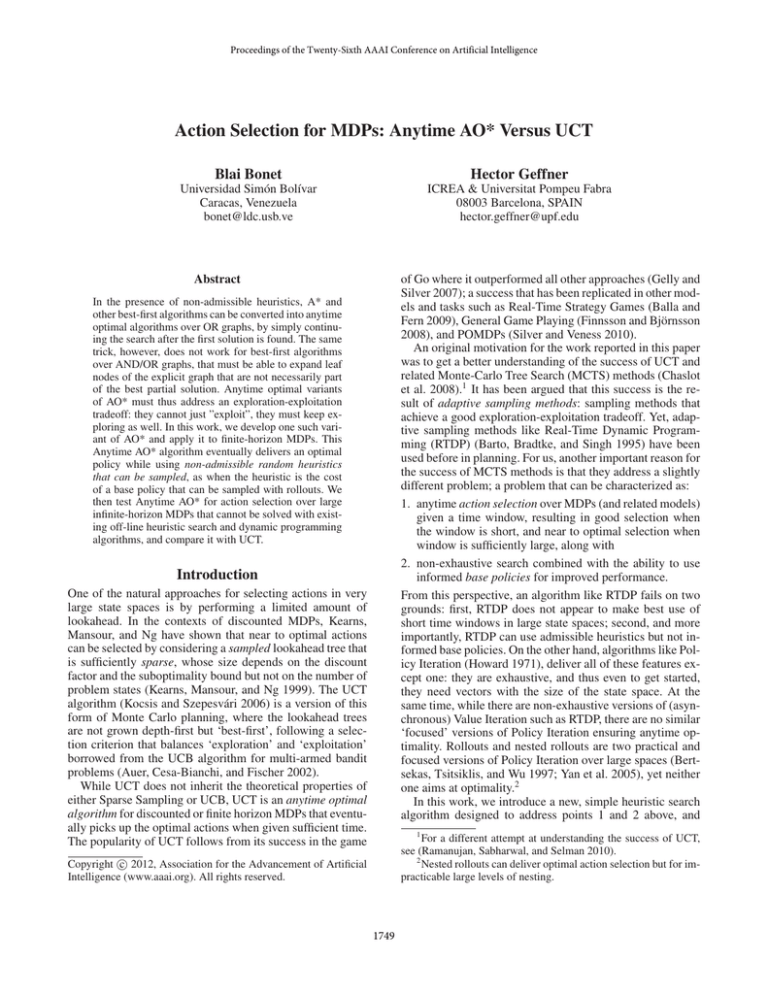
Proceedings of the Twenty-Sixth AAAI Conference on Artificial Intelligence
Action Selection for MDPs: Anytime AO* Versus UCT
Blai Bonet
Hector Geffner
Universidad Simón Bolı́var
Caracas, Venezuela
bonet@ldc.usb.ve
ICREA & Universitat Pompeu Fabra
08003 Barcelona, SPAIN
hector.geffner@upf.edu
Abstract
of Go where it outperformed all other approaches (Gelly and
Silver 2007); a success that has been replicated in other models and tasks such as Real-Time Strategy Games (Balla and
Fern 2009), General Game Playing (Finnsson and Björnsson
2008), and POMDPs (Silver and Veness 2010).
An original motivation for the work reported in this paper
was to get a better understanding of the success of UCT and
related Monte-Carlo Tree Search (MCTS) methods (Chaslot
et al. 2008).1 It has been argued that this success is the result of adaptive sampling methods: sampling methods that
achieve a good exploration-exploitation tradeoff. Yet, adaptive sampling methods like Real-Time Dynamic Programming (RTDP) (Barto, Bradtke, and Singh 1995) have been
used before in planning. For us, another important reason for
the success of MCTS methods is that they address a slightly
different problem; a problem that can be characterized as:
1. anytime action selection over MDPs (and related models)
given a time window, resulting in good selection when
the window is short, and near to optimal selection when
window is sufficiently large, along with
2. non-exhaustive search combined with the ability to use
informed base policies for improved performance.
From this perspective, an algorithm like RTDP fails on two
grounds: first, RTDP does not appear to make best use of
short time windows in large state spaces; second, and more
importantly, RTDP can use admissible heuristics but not informed base policies. On the other hand, algorithms like Policy Iteration (Howard 1971), deliver all of these features except one: they are exhaustive, and thus even to get started,
they need vectors with the size of the state space. At the
same time, while there are non-exhaustive versions of (asynchronous) Value Iteration such as RTDP, there are no similar
‘focused’ versions of Policy Iteration ensuring anytime optimality. Rollouts and nested rollouts are two practical and
focused versions of Policy Iteration over large spaces (Bertsekas, Tsitsiklis, and Wu 1997; Yan et al. 2005), yet neither
one aims at optimality.2
In this work, we introduce a new, simple heuristic search
algorithm designed to address points 1 and 2 above, and
In the presence of non-admissible heuristics, A* and
other best-first algorithms can be converted into anytime
optimal algorithms over OR graphs, by simply continuing the search after the first solution is found. The same
trick, however, does not work for best-first algorithms
over AND/OR graphs, that must be able to expand leaf
nodes of the explicit graph that are not necessarily part
of the best partial solution. Anytime optimal variants
of AO* must thus address an exploration-exploitation
tradeoff: they cannot just ”exploit”, they must keep exploring as well. In this work, we develop one such variant of AO* and apply it to finite-horizon MDPs. This
Anytime AO* algorithm eventually delivers an optimal
policy while using non-admissible random heuristics
that can be sampled, as when the heuristic is the cost
of a base policy that can be sampled with rollouts. We
then test Anytime AO* for action selection over large
infinite-horizon MDPs that cannot be solved with existing off-line heuristic search and dynamic programming
algorithms, and compare it with UCT.
Introduction
One of the natural approaches for selecting actions in very
large state spaces is by performing a limited amount of
lookahead. In the contexts of discounted MDPs, Kearns,
Mansour, and Ng have shown that near to optimal actions
can be selected by considering a sampled lookahead tree that
is sufficiently sparse, whose size depends on the discount
factor and the suboptimality bound but not on the number of
problem states (Kearns, Mansour, and Ng 1999). The UCT
algorithm (Kocsis and Szepesvári 2006) is a version of this
form of Monte Carlo planning, where the lookahead trees
are not grown depth-first but ‘best-first’, following a selection criterion that balances ‘exploration’ and ‘exploitation’
borrowed from the UCB algorithm for multi-armed bandit
problems (Auer, Cesa-Bianchi, and Fischer 2002).
While UCT does not inherit the theoretical properties of
either Sparse Sampling or UCB, UCT is an anytime optimal
algorithm for discounted or finite horizon MDPs that eventually picks up the optimal actions when given sufficient time.
The popularity of UCT follows from its success in the game
1
For a different attempt at understanding the success of UCT,
see (Ramanujan, Sabharwal, and Selman 2010).
2
Nested rollouts can deliver optimal action selection but for impracticable large levels of nesting.
c 2012, Association for the Advancement of Artificial
Copyright Intelligence (www.aaai.org). All rights reserved.
1749
AO*
compare it with UCT. We call the new algorithm Anytime
AO*, because it is a very simple variation of the classical AO* algorithm for AND/OR graphs (Nilsson 1980) that
is optimal even in the presence of non-admissible heuristics. Anytime AO* is related to recent anytime and on-line
heuristic search algorithms for OR graphs (Likhachev, Gordon, and Thrun 2003; Hansen and Zhou 2007; Koenig and
Sun 2009; Thayer and Ruml 2010). It is well known that
A* and other best-first algorithms can be easily converted
into anytime optimal algorithms in the presence of nonadmissible heuristics by simply continuing the search after
the first solution is found. The same trick, however, does
not work for best-first algorithms over AND/OR graphs that
must be able to expand leaf nodes of the explicit graph that
are not part of the best partial solution. Thus, Anytime AO*
differs from AO* in two main points: first, with probability
p, it expands leaf nodes that are not part of the best partial solution; second, the search finishes when time is up or
there are no more leaf nodes to expand at all (not just in the
best solution graph). Anytime AO* delivers an optimal policy eventually and can also use random heuristics that are
not admissible and can be sampled, as when the heuristics
result from rollouts of a given base policy.
A finite horizon MDP defines an implicit AND/OR graph
that can be solved by the well-known AO* algorithm (Nilsson 1980). The root node of this graph is the pair (s0 , H)
where s0 is the initial state and H is the horizon, while the
terminal nodes are of the form (s, d) where s is a state and d
is 0, or s is a terminal state (goal or dead-end). The children
of a non-terminal node (s, d) are the triplets (a, s, d) where
a is an action in A(s), while the children of a node (a, s, d)
are the nodes (s0 , d−1) where s0 is a possible successor state
of a in s; i.e., Pa (s0 |s) > 0. Non-terminal nodes of the form
(s, d) are OR-nodes where an action needs to be selected,
while nodes (a, s, d) are non-terminal AND-nodes.
The solutions graphs to these AND/OR graphs are defined
in the standard way; they include the root node (s0 , H),
and recursively, one child of every OR-node and all children of every AND-node. The value of a solution is defined
recursively: the leaves have value equal to 0, the OR-nodes
(s, d) have value equal to the value of the selected child,
and the AND-nodes (a, s, d) have value equal to the cost
of the action a in s plus the sum of the values for the children (s0 , d−1) weighted by their probabilities Pa (s0 |s). The
optimal solution graph yields a minimum value to the root
node (cost setting), and can be computed as part of the evaluation procedure, marking the best child (min cost child) for
each OR-node. This procedure is called backward induction.
The algorithm AO* computes an optimal solution graph in
a more selective and incremental manner, using a heuristic
function h over the nodes of the graph that is admissible or
optimistic (does not overestimate in the cost setting).
AO* maintains a graph G that explicates part of the implicit AND/OR graph, the explicit graph, and a second graph
G∗ , the best partial solution, that represents an optimal solution of G under the assumption that the tips n of G are
the terminal nodes with values given by the heuristic h(n).
Initially, G contains the root node of the implicit graph only,
and G∗ is G. Then, iteratively, a non-terminal leaf node is selected from the best partial solution G∗ , and the children of
this node in the implicit graph are explicated in G. The best
partial solution of G is then revised by applying an incremental form of backward induction, setting the values of the
leaves in G to their heuristic values. The procedure finishes
when there are no leaf nodes in the best partial graph G∗ . If
the heuristic values are optimistic, the best partial solution
G∗ is an optimal solution to the implicit AND/OR graph,
which is partially explicated in G. In the best case, G ends
up containing no more nodes than those in the best solution
graph; in the worst case, G ends up explicating all the nodes
in the implicit graph. Code for AO* is shown in Fig. 1. The
choice of which non-terminal leaf node in the best partial
graph to expand is important for performance but is not part
of the algorithm and it does not affect its optimality.
MDPs
Markov Decision Processes are fully observable, stochastic
state models. In the discounted reward formulation, an MDP
is given by a set S of states, sets A(s) of actions applicable in
each state s, transition probabilities Pa (s0 |s) of moving from
s into s0 when the action a ∈ A(s) is applied, real rewards
r(a, s) for doing action a in the state s, and a discount factor
γ, 0 < γ < 1. A solution is a policy π selecting an action
π(s) ∈ A(s) in each state s ∈ S. A policy is optimal if it
maximizes the expected accumulated discounted reward.
Undiscounted finite horizon MDPs replace the discount
factor γ by a positive integer horizon H. The policies for
such MDPs are functions mapping nodes (s, d) into actions
a ∈ A(s), where s is a state and d is the horizon to go,
0 < d ≤ H. Optimal policies maximize the total reward
that can be accumulated in H steps. Finite horizon MDPs
are acyclic as all actions decrement the horizon to go by 1.
Undiscounted infinite horizon MDPs are like discounted
MDPs but with discount γ = 1. For such MDPs to have
well-defined solutions, it is common to assume that rewards
are negative, and thus represent positive costs, except in certain goal states that are cost-free and absorbing. If these goal
states are reachable from all the other states with positive
probability, the set of optimal policies is well defined.
The MDPs above are reward-based. AO* is used normally
in a cost setting, where rewards r(a, s) are replaced by costs
c(a, s), and maximization is replaced by minimization. The
two points of view are equivalent, and we will use one or the
other when most convenient.
We are interested in the problem of selecting the action
to do in the current state of a given infinite horizon MDPs,
whether discounted or undiscounted. This will be achieved
by a lookahead that uses a limited time window to run an
anytime optimal algorithm over the version of the MDP that
results from fixing the horizon.
UCT
UCT has some of the flavour of AO* and it is often presented as a best-first search algorithm too.3 Indeed, UCT
3
This is technically wrong though, as a best-first algorithm just
expands nodes in the best partial solution in correspondence to
1750
AO*: G is explicit graph, initially empty; h is heuristic function.
UCT(s, d): G is explicit graph, initially empty; π is base policy; C is
exploration constant.
1. If d = 0 or s is terminal, Return 0
2. If node (s, d) is not in explicit graph G, then
– Add node (s, d) to explicit graph G
– Initialize N (s, d) := 0 and N (a, s, d) := 0 for all a ∈ A(s)
– Initialize Q(a, s, d) := 0 for all a ∈ A(s)
– Obtain sampled accumulated discounted reward r(π, s, d)
by simulating base policy π for d steps starting at s
– Return r(π, s, d)
3. If node (s, d) is in explicit graph G,
p
– Let Bonus(a) = C 2 log N (s, d)/N (a, s, d) if N (a, s, d) > 0,
else ∞, for each a ∈ A(s)
– Select action a = argmaxa∈A(s) [Q(a, s, d) + Bonus(a)]
– Sample state s0 with probability Pa (s0 |s)
– Let nv = r(s, a) + γUCT(s0 , d − 1)
– Increment N (s, d) and N (a, s, d)
– Set Q(a, s, d) := Q(a, s, d) + [nv − Q(a, s, d)]/N (a, s, d)
– Return nv
Initialization
1. Insert node (s, H) in G where s is the initial state
2. Initialize V (s, H) := h(s, H)
3. Initialize best partial graph to G
Loop
4. Select non-terminal tip node (s, d) in best partial graph. If there is
no such node, Exit.
5. Expand node (s, d): for each a ∈ A(s), add node (a, s, d) as child
of (s, d), and for each s0 with Pa (s0 |s) > 0, add node (s0 , d − 1)
as child of (a, s, d). Initialize values V (s0 , d − 1) for new nodes
(s0 , d − 1) as 0 if d − 1 = 0, or h(s0 , d − 1) otherwise.
6. Update ancestors AND and OR nodes of (s, d) in G, bottom-up as:
P
Q(a, s, d) := c(a, s) + γ s0 Pa (s0 |s)V (s0 , d − 1),
V (s, d) := mina∈A(s) Q(a, s, d).
7. Mark best action in ancestor OR-nodes (s, d) to any action a such
that V (s, d) = Q(a, s, d), maintaining marked action if still best.
8. Recompute best partial graph by following marked actions.
Figure 2: UCT for Finite-Horizon Reward-based MDPs.
Figure 1: AO* for Finite Horizon Cost-based MDPs.
ups as in AO* or Value Iteration, but through Monte-Carlo
backups that extend the current average with a new sampled
value (Sutton and Barto 1998); see Fig. 2 for details.
It can be shown that UCT eventually explicates the whole
finite horizon MDP graph, and that it converges to the optimal policy asymptotically. Unlike AO*, however, UCT
does not have a termination condition, and moreover, UCT
does not necessarily add a new node to the graph in every iteration, even when there are such nodes to explicate. Indeed, while in the worst case, AO* converges in
a number of iterations that is bounded by the number of
nodes in the implicit graph, UCT may require an exponential number of iterations (Munos and Coquelin 2007;
Walsh, Goschin, and Littman 2010). On the other hand,
AO* is a model-based approach to planning that assumes
that the probabilities and costs are known, while UCT is a
simulation-based approach that just requires a simulator that
can be reset to the current state.
The differences between UCT and AO* are in the leafs
of the graphs selected for expansion, the way they are expanded, the values to which they are initialized, and how
the values are propagated. These dimensions are the ones
used to define a family of Monte Carlo Tree Search (MCTS)
methods that includes UCT as the best known member
(Chaslot et al. 2008). The feature that is common to this family of methods is the use of Monte Carlo simulations to evaluate the leafs of the graph. The resulting values are heuristic,
although not necessarily optimistic as required for the optimality of AO*. One way to bridge the gap between AO* and
MCTS methods is by modifying AO* to accommodate nonadmissible heuristics, and moreover, random heuristics that
can be sampled such as the cost of a base policy.
maintains an explicit partial graph that is expanded incrementally like the graph G in AO*. The main differences are
in how leaf nodes of this graph are selected and expanded,
and how heuristic values for leafs are obtained and propagated. The code for UCT, which is more naturally described
as a recursive algorithm, is shown in Fig. 2.
UCT consists of a sequence of stochastic simulations,
like RTDP, that start at the root node. However, while the
choice of successor states is stochastic, the choice of the
actions is not greedy on the action Q-values as in RTDP,
but greedy
p on the sum of the action Q-values and a bonus
term C 2 log N (s, d)/N (a, s, d) that ensures that all applicable actions are tried in all states infinitely often at suitable
rates. Here, C is an exploration constant, and N (s, d) and
N (a, s, d) are counters that track the number of simulations
that had passed through the node (s, d) and the number of
times that action a has been selected at such node.
The counters N (a, d) and N (a, s, d) are maintained for
the nodes in the explicit graph that is extended incrementally, starting like in AO*, with the single root node (s, H).
The simulations start at the root and terminate at a terminal node or at the first node (s, d) that is not in the graph.
In between, UCT selects an action a that is greedy on the
stored value Q(a, s, d) plus the bonus term, samples the next
state s0 with probability Pa (s0 |s), increments the counters
N (s, d) and N (a, s, d), and generates the node (s0 , d − 1).
When a node (s, d) is generated that is not in the explicit
graph, the node is added to the explicit graph, the registers
N (s, d), N (a, s, d), and Q(a, s, d) are allocated and initialized to 0, and a total discounted reward r(π, s, d) is sampled,
by simulating a base policy π for d steps starting at s, and
propagated upward along the nodes in the simulated path.
These values are not propagated using full Bellman back-
Anytime AO*
Anytime AO* involves two small changes from AO*. The
first, shown in Fig. 3, is for handling non-admissible heuris-
what is called ‘exploitation’. Yet UCT as the other MCTS algorithms, and Anytime AO* below, do ‘exploration’ as well.
1751
action in n, else is minb [∆(n), Q(nb )−V (n)], for b =
6 a.
Anytime AO* with possibly non-admissible heuristic h: same code as
AO* except for extra parameter p, 0 ≤ p ≤ 1, and line 4 in Loop for
tip selection replaced by 4.1 and 4.2 below.
4.1. Choose IN with probability 1 − p, else Choose OUT:
• IN: Select non-terminal tip node (s, d) from explicit graph G
that is IN the best partial graph.
• OUT: Select non-terminal tip node (s, d) from explicit graph G
that is NOT in the best partial graph.
4.2. If there is no node (s, d) satisfying the choice condition, make the
other choice. If there is no node satisfying either choice condition,
Exit the loop.
3. For children na = (a, s, d) of node (s, d) that is not in
the best solution graph, ∆(na ) is ∆(n) + V (n) − Q(na ).
4. For children ns0 = (s0 , d − 1) of node na = (a, s, d),
∆(ns0 ) is ∆(na )/γPa (s0 |s).
The tip nodes (s, d) that are chosen for expansion are the
ones that minimize the values |∆(s, d)|. Since this computation is expensive, as it involves a complete traversal of the
explicit graph G, we select N ≥ 1 tip nodes for expansion
at a time. This selection is implemented by using two priority queues during the graph traversal: one for selecting the
best N tips in the solution graph (IN), and one for selecting
the best N tips OUT. The first selected tip is the one with
min |∆(s, d)| in the IN queue with probability 1 − p and in
the OUT queue otherwise. Once selected, the tip is removed
from the queue, and the process is repeated N times.
Figure 3: Anytime AO*. If the heuristic h(s, d) is random, as
when representing the cost of a given base policy; see text.
tics: rather than always selecting a non-terminal tip node
from the explicit graph that is IN the best partial graph,
Anytime AO* selects with probability p a non-terminal tip
node from the explicit graph that is OUT of the best partial
graph. The probability p is a given parameter between 0 and
1, by default 1/2. Of course, if a choice for an IN node is
decided (a tip in the best partial graph) but there is no such
node, then an OUT choice is forced, and vice versa. Anytime
AO* terminates when neither IN or OUT choices are possible; i.e., when no tip nodes in the explicit graph are left, or
when the time is up.
It is easy to see that Anytime AO* is optimal, whether the
heuristic is admissible or not, because it terminates when the
implicit graph has been fully explicated. In the worst case,
the complexity of Anytime AO* is not worse than AO*, as
AO* expands the complete graph in the worst case too.
The second change in Anytime AO*, not shown in the figure, is for dealing with random heuristics h. Basically, when
the value V (s, d) of a tip node (s, d) is set to a heuristic
h(s, d) that is a random variable, such as the reward obtained by following a base policy d steps from s, Anytime
AO* uses samples of h(s, d) until the node (s, d) is expanded. Until then, a ‘fetch for value’ V (s, d), which occurs
each time that a parent node of (s, d) is updated, results in a
new sample of h(s, d) which is averaged with the previous
ones. This is implemented in standard fashion by incrementally updating the value V (s, d) using a counter N (s, d) and
the new sample. These counters are no longer needed when
the node (s, d) is expanded, as then the value of the node is
given by the value of its children in the graph.
Experimental Results
We have evaluated Anytime AO* (abbreviated AOT) vs.
UCT as an action selection mechanism over a number of
MDPs. In each case, we run the planning algorithm for a
number of iterations from the current state s, apply the best
action according to the resulting Q(a, s, H) values, where
H is the planning horizon, and repeat the loop from the state
that results until the goal is reached. The quality profile of
the algorithms is given by the average cost to the goal as a
function of the time window for action selection. Each data
point in the profiles (and table) is the average over 1,000
sampled episodes that finish when the goal is reached or after 100 steps. For the profiles, the x-axis stands for the average time per action selected, and the y-axis for the average
cost to the goal. AOT was run with parameter p = 0.5 (i.e.,
equal probability for IN and OUT choices), and UCT with
the exploration ‘constant’ C set to current Q(a, s, d) value
of the node; a choice that appears to be standard (Balla and
Fern 2009; Eyerich, Keller, and Helmert 2010). The N parameter for the computation of the ∆’s was set as a fraction k
of the number of iterations, k = 1/10.4 The actual codes for
UCT and AOT differ from the ones shown in that they deal
with graphs instead of trees; i.e., there are duplicates (s, d)
with the same state s and depth d. The same applies to the
computation of the ∆’s. All experiments were run on Xeon
’Woodcrest’ computers of 2.33 GHz and 8 Gb of RAM.
CTP. The Canadian Traveller Problem is a path finding
problem over a graph whose edges (roads) may be blocked
(Papadimitriou and Yannakakis 1991). Each edge is blocked
with a given prior probability, and the status of an edge
(blocked or free) can be sensed noise-free from either end
of the edge. The problem is an acyclic POMDP that results
in a belief MDP whose states are given by the agent position, and edge beliefs that can take 3 values: prior, known
to be blocked, and known to be free. If the number of nodes
Choice of Tip Nodes in Anytime AO*
AO* and Anytime AO* leave open the criterion for selecting the tip node to expand. For the experiments, we use a
selection criterion aimed at selecting the tip nodes that can
have the biggest potential impact in the best partial graph.
For this, a function ∆(n) is introduced that measures the
change in the value of the node n that is needed in order to
produce a change in the best partial graph. The function ∆
is defined top-down over the explicit graph as:
4
The number of tip nodes in UCT is bounded by the number of
iterations (rollouts). In AOT, the number of tips is bounded in the
worst case by the number of iterations (expansions) multiplied by
|A||S|, where |A| and |S| are the number of actions and states.
1. For the root node, ∆(s, H) = ∞.
2. For children na = (a, s, d) of node (s, d) in the best solution graph, ∆(na ) is [V (n)−Q(na )] if a is not the best
1752
br. factor
prob. P (bad)
avg max
UCT–CTP
random base policy
optimistic base policy
UCTB
UCTO
direct
UCT
AOT
direct
UCT
AOT
10-1
10-2
10-3
10-4
10-5
10-6
10-7
10-8
10-9
10-10
total
19.9
45.6
21.9
1.4
22.7
24.9
4.1
14.1
28.1
31.1
8.5
6.5
8.9
11.4
7.2
7.1
11.0
8.0
12.7
9.4
32
64
16
32
16
32
32
32
32
32
114.8 ± 3
102.5 ± 2
127.2 ± 3
58.0 ± 2
89.3 ± 2
111.5 ± 3
83.3 ± 2
87.0 ± 1
72.0 ± 3
76.7 ± 2
922.3
101.3 ± 3
99.9 ± 2
115.2 ± 3
53.4 ± 2
86.1 ± 2
92.6 ± 2
66.7 ± 1
74.6 ± 1
66.5 ± 2
75.4 ± 2
831.7
324.7 ± 5
254.8 ± 4
313.2 ± 4
276.4 ± 5
224.4 ± 3
225.4 ± 3
244.8 ± 4
230.9 ± 3
177.6 ± 4
200.0 ± 4
2472.2
108.4 ± 1
101.1 ± 1
127.1 ± 1
55.9 ± 1
91.3 ± 1
121.4 ± 1
83.9 ± 1
107.1 ± 1
71.5 ± 1
79.5 ± 1
947.2
103.1 ± 1
98.3 ± 1
125.3 ± 1
54.4 ± 1
90.0 ± 1
102.9 ± 1
69.9 ± 1
78.3 ± 0
66.7 ± 1
74.5 ± 1
863.4
102.8 ± 1
145.9 ± 2
125.0 ± 1
53.0 ± 1
86.7 ± 1
105.0 ± 1
118.4 ± 2
75.0 ± 0
63.7 ± 1
76.9 ± 1
952.4
106.1 ± 1
97.9 ± 1
118.7 ± 1
53.6 ± 1
89.3 ± 1
105.4 ± 1
74.5 ± 0
81.8 ± 0
68.1 ± 1
75.2 ± 1
870.6
102.2 ± 1
99.1 ± 1
116.5 ± 1
52.5 ± 1
94.4 ± 1
96.0 ± 1
69.0 ± 0
76.1 ± 0
66.7 ± 1
82.7 ± 1
855.2
20-1
20-2
20-3
20-4
20-5
20-6
20-7
20-8
20-9
20-10
total
17.9
9.5
14.3
78.6
20.4
14.4
8.4
23.3
33.0
12.1
13.5
15.7
15.2
11.4
15.0
13.9
14.3
15.0
14.6
15.3
128
64
128
64
64
64
128
64
128
64
210.7 ± 7
176.4 ± 4
150.7 ± 7
264.8 ± 9
123.2 ± 7
165.4 ± 6
191.6 ± 6
160.1 ± 7
235.2 ± 6
180.8 ± 7
1858.9
169.0 ± 6
148.9 ± 3
132.5 ± 6
235.2 ± 7
111.3 ± 5
133.1 ± 3
148.2 ± 4
134.5 ± 5
173.9 ± 4
167.0 ± 5
1553.6
1000.3 ± 1
676.6 ± 1
571.7 ± 1
861.4 ± 1
586.2 ± 1
670.7 ± 1
862.9 ± 1
704.0 ± 1
783.4 ± 1
825.7 ± 1
7542.9
216.4 ± 3
178.5 ± 2
169.7 ± 4
264.1 ± 4
139.8 ± 4
178.0 ± 3
211.8 ± 3
218.5 ± 4
251.9 ± 3
185.7 ± 3
2014.4
187.4 ± 3
167.4 ± 2
140.7 ± 3
261.0 ± 4
128.3 ± 3
160.0 ± 2
170.2 ± 2
154.6 ± 3
213.7 ± 2
180.5 ± 3
1763.8
191.8 ± 0
202.7 ± 0
142.1 ± 0
267.9 ± 0
163.1 ± 0
193.5 ± 0
171.3 ± 0
167.9 ± 0
212.8 ± 0
173.2 ± 0
1886.3
180.7 ± 3
160.8 ± 2
144.3 ± 3
238.3 ± 3
123.9 ± 3
167.8 ± 2
174.1 ± 2
152.3 ± 3
185.2 ± 2
178.5 ± 3
1705.9
163.8 ± 2
156.4 ± 1
133.8 ± 2
233.4 ± 3
109.4 ± 2
135.5 ± 1
145.1 ± 1
135.9 ± 2
173.3 ± 1
166.4 ± 2
1553.0
Table 1: CTP instances with 10 and 20 nodes. P (bad) is probability (in percentage) of the instance not being solvable, and max branching
factor is 2m where m + 1 is the number of edges with a common node in CTP graph. UCTB and UCTO are two domain-dependent UCT
implementations (Eyerich, Keller, and Helmert 2010), π refers to the base policy in our domain-independent UCT and AOT algorithms,
whose base performance is shown as well. UCT run for 10,000 iterations and AOT for 1,000. Boldface figures are best in whole table; gray
cells show best among domain-independent implementations.
is n and the number of edges in the graph is m, the number of MDP states is n × 3m . The problem has been addressed recently using a domain-specific implementation of
UCT (Eyerich, Keller, and Helmert 2010). We consider instances with 20 nodes from that paper and instances with 10
nodes obtained from the authors. Following Eyerich, Keller
and Helmert, the actions are identified with moves to any
node in the frontier of the known graph. The horizon H can
then be set to the number of nodes in the graph.
Quality profiles are shown in Fig. 4 for instances 10-7 and
20-7. On each panel, results on the left are for UCT and AOT
using the base random policy, while results on the right are
for the base optimistic policy that assumes that all edges of
unknown status are traversable. The points for UCT correspond to running 10, 50, 100, 500, 1k, 5k, 10k and 50k iterations (rollouts), resulting in the times shown. The points for
AOT, correspond to running 10, 50, 100, 500, 1k, 5k, 10k iterations (expansions). Points that time out are not displayed.
The curves show that AOT performs better than UCT except
up to the time window of 1 second in the instance 20-7 for
the random base policy. We have computed the curves for
the 20 instances and the pattern is similar (but not shown for
lack of space). A comprehensive view of the results is shown
in Table 1. As a reference, we include also the results for
two specialized implementations of UCT, UCTB and UCTO
(Eyerich, Keller, and Helmert 2010), that take advantage of
the specific MDP structure of the CTP, use a more informed
base policy, and actually solve a slightly simpler version of
the problem where the given CTP is solvable. While all the
algorithms are evaluated over solvable instances, AOT and
Figure 5: Quality profiles for Sailing and Racetrack.
our UCT solve the harder problem of getting to the target location if the problem is solvable, and determining otherwise
that the problem is unsolvable. In some instances, the edge
priors are such that the probability of an instance not being
solvable is high. This is shown as the probability of ‘bad
weather’ in the second column of the table. In spite of these
differences, AOT improves upon the domain-specific implementation of UCT in several cases, and practically dominates the domain-independent version. Since UCTO is the
state of the art in CTP, the results show that our domainindependent implementations of both AOT and UCT are
good enough, and that AOT in particular appears to be competitive with the state of the art in this domain.
Sailing and Racetrack. The Sailing domain is similar to
the one in the original UCT paper (Kocsis and Szepesvári
2006). The profile for a 100 × 100 instance with 80,000
states is shown in the left panel of Fig. 5 for a random base
1753
(a) 10-7
(b) 20-7
Figure 4: Quality profiles for CTP instances 10-7 and 20-7.
policy. The problem has a discount γ = 0.95 and the optimal value is 26.08. UCT and AOT are run with horizon
H = 50. Profiles for other instances show the same pattern:
AOT is slower to get started because of the more expensive expansions, but then learns faster. The profile for the instance ’barto-big’ of the Racetrack domain (Barto, Bradtke,
and Singh 1995) is shown in the right panel of Fig. 5. In this
case, AOT converges much faster than UCT.
Base Policies, Heuristics, and RTDP. We also performed
experiments comparing the use of heuristics h vs. base policies π for initializing the value of tip nodes in AOT. We refer
to AOT using π as a base policy as AOT(π), and to AOT using the heuristic h as AOT(h). Clearly, the overhead per iteration is smaller in AOT(h) than in AOT(π) that must do a
full rollout of π to evaluate a tip node. Results of AOT(π) vs.
AOT(h) on the instances 20-1 and 20-4 of CTP are shown in
Fig. 6 with both the zero heuristic and the min-min heuristic (Bonet and Geffner 2003). The base policy π is the policy πh that is greedy with respect to h with πh being the
random policy when h = 0. The curves also show the performance of LRTDP (Bonet and Geffner 2003), used as an
anytime action selection mechanism that is run over the same
finite-horizon MDP as AOT and with the same heuristic h.
Interestingly, when LRTDP is used in this form, as opposed
to an off-line planning algorithm, LRTDP does rather well
on CTP too, where there is no clear dominance between
AOT(πh ), AOT(h), and LRTDP(h). The curves for the instance 20-1 are rather typical of the CTP instances. For the
zero heuristic, AOT(h) does better than LRTDP(h) which
does better than AOT(πh ). On the other hand, for the minmin heuristic, the ranking is reversed but with differences
in performance being smaller. There are some exceptions
to this pattern where AOT(πh ) does better, and even much
better than both AOT(h) and LRTDP(h) for the two heuristics. One such instance, 20-4, is shown in the bottom part of
Fig. 6.
Figure 7 shows the same comparison for a Racetrack instance and three variations hd of the min-min heuristic hmin ,
hd = d × hmin for d = 2, 1, 1/2. Notice that multiplying an heuristic h by a constant d has no effect on the policy πh that is greedy with respect to h, and hence no effect on AOT(πhd ). On the other hand, these changes affect both AOT(hd ) and LRTDP(hd ). As expected the performance of LRTDP(hd ) deteriorates for d < 1, but some-
Figure 6: AOT(πh ), AOT(h), and LRTDP(h) on two CTP
instances for h = 0 and hmin . Policy πh is greedy in h.
what surprisingly, improves for d > 1 even as the resulting
heuristic is not (necessarily) admissible. For small time windows, AOT(hd ) does worse than LRTDP(hd ), but for larger
windows AOT(hd ) catches up, and in two cases surpasses
LRTDP(hd ). In these cases, AOT with the greedy base policy πh appears to do best of all.
Leaf Selection. We have also tested the value of the leaf
selection method used in AOT by comparing the ∆-based
selection of tips vs. random tip selection. It turns out that the
former pays off, in particular, when the base policies are not
informed. Some results are shown in Fig. 8.
The results obtained from the experiments above are not
conclusive. They show however that the new AOT algorithm, while a simple variation of the standard AO* algorithm, appears to be competitive with both UCT and LRTDP,
while producing state-of-the-art results in the CTP domain.
Conclusions
The algorithm UCT addresses the problem of anytime action
selection over MDPs and related models, combining a non-
1754
Bonet, B., and Geffner, H. 2003. Labeled RTDP: Improving the convergence of real-time dynamic programming. In
Proc. ICAPS, 12–31.
Chaslot, G.; Winands, M.; Herik, H.; Uiterwijk, J.; and
Bouzy, B. 2008. Progressive strategies for monte-carlo tree
search. New Math. and Natural Comp. 4(3):343.
Eyerich, P.; Keller, T.; and Helmert, M. 2010. High-quality
policies for the canadian traveler’s problem. In Proc. AAAI.
Finnsson, H., and Björnsson, Y. 2008. Simulation-based
approach to general game playing. In Proc. AAAI, 259–264.
Gelly, S., and Silver, D. 2007. Combining online and offline
knowledge in uct. In Proc. ICML, 273–280.
Hansen, E., and Zhou, R. 2007. Anytime heuristic search.
J. Artif. Intell. Res. 28:267–297.
Howard, R. 1971. Dynamic Probabilistic Systems–Volume
I: Markov Models. New York: Wiley.
Kearns, M.; Mansour, Y.; and Ng, A. 1999. A sparse sampling algorithm for near-optimal planning in large MDPs. In
Proc. IJCAI-99, 1324–1331.
Kocsis, L., and Szepesvári, C. 2006. Bandit based MonteCarlo planning. In Proc. ECML-2006, 282–293.
Koenig, S., and Sun, X. 2009. Comparing real-time and incremental heuristic search for real-time situated agents. Autonomous Agents and Multi-Agent Systems 18(3):313–341.
Likhachev, M.; Gordon, G.; and Thrun, S. 2003. ARA*:
Anytime A* with provable bounds on sub-optimality. In
Proc. NIPS.
Munos, R., and Coquelin, P. 2007. Bandit algorithms for
tree search. In Proc. UAI, 67–74.
Nilsson, N. 1980. Principles of Artificial Intelligence. Tioga.
Papadimitriou, C., and Yannakakis, M. 1991. Shortest paths
without a map. Theoretical Comp. Sci. 84(1):127–150.
Ramanujan, R.; Sabharwal, A.; and Selman, B. 2010. On
adversarial search spaces and sampling-based planning. In
Proc. ICAPS, 242–245.
Silver, D., and Veness, J. 2010. Monte-carlo planning in
large POMDPs. In Proc. NIPS, 2164–2172.
Sutton, R., and Barto, A. 1998. Introduction to Reinforcement Learning. MIT Press.
Thayer, J., and Ruml, W. 2010. Anytime heuristic search:
Frameworks and algorithms. In Proc. SOCS.
Walsh, T.; Goschin, S.; and Littman, M. 2010. Integrating sample-based planning and model-based reinforcement
learning. In Proc. AAAI.
Yan, X.; Diaconis, P.; Rusmevichientong, P.; and Van Roy,
B. 2005. Solitaire: Man versus machine. In Proc. NIPS 17.
Figure 7: AOT(πh ), AOT(h), and LRTDP(h) on Racetrack
instance for h = d × hmin and d = 2, 1, 1/2.
Figure 8: Random vs. ∆-based tip selection. Problem 10-7.
exhaustive search with the ability to use informed base policies. In this work, we have developed a new algorithm for
this task and showed that it compares well with UCT. The
new algorithm, Anytime AO* (AOT) is a very small variation of AO* that retains the optimality of AO* and its worst
case complexity, yet it does not require admissible heuristics and can use base policies. The work helps to bridge
the gap between Monte-Carlo Tree Search (MCTS) methods and anytime heuristic search methods, both of which
have flourished in recent years, the former over AND/OR
Graphs and Game Trees, the latter over OR graphs. The relation of Anytime AO* to both classes of methods suggest
also a number of extensions that are worth exploring in the
future.
Acknowledgments. H. Geffner is partially supported by
grants TIN2009-10232, MICINN, Spain, and EC-7PMSpaceBook.
References
Auer, P.; Cesa-Bianchi, N.; and Fischer, P. 2002. Finitetime analysis of the multiarmed bandit problem. Machine
learning 47(2):235–256.
Balla, R., and Fern, A. 2009. UCT for tactical assault planning in real-time strategy games. In Proc. IJCAI-09, 40–45.
Barto, A.; Bradtke, S.; and Singh, S. 1995. Learning to
act using real-time dynamic programming. Artificial Intelligence 72:81–138.
Bertsekas, D.; Tsitsiklis, J.; and Wu, C. 1997. Rollout algorithms for combinatorial optimization. J. of Heuristics
3(3):245–262.
1755


